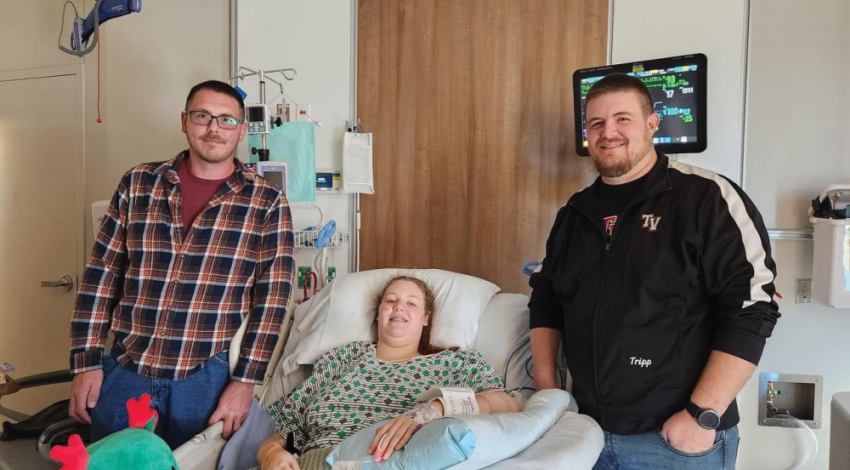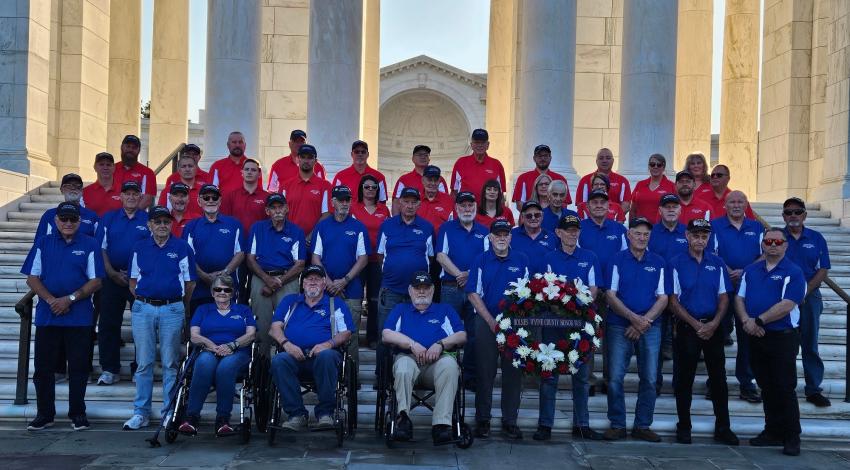Army Veteran Rudy Dalrymple constructs paper poppy flowers.
Rudy Dalrymple leaves his room at the Ohio Veterans Home in Sandusky between 5 and 5:30 a.m. most days, and settles into a comfortable padded chair behind his sturdy worktable. Using crepe paper, wire, cloth tape, and his trusty wooden crimping tool, he forms delicate poppy blossoms, one after another, again and again, until he’s surrounded by a mound of flowers, which are destined for American Legion auxiliaries across Ohio to use in their major fundraising efforts around Memorial Day.
May means poppy time for the auxiliaries, when members work the local churches, banks, supermarkets, and shopping centers to solicit donations, in exchange for the ubiquitous flowers — every one of which is handmade by veterans such as Dalrymple, a Vietnam War veteran originally from Defiance, who has been making the flowers since 1988.
Where it all happens
The Auxiliary maintains its Poppy Shop on the 99-acre grounds of the Veterans Home in Sandusky, the only place in the state where that work goes on year-round. According to Patricia Taylor, the auxiliary’s poppy chairman, the 2017 goal is nearly 400,000 poppies.
Dalrymple certainly does his part. He “cuts out” periodically for coffee breaks, and usually takes a lunch around 10 a.m., but his workday seldom ends before 6 p.m. He works slowly and steadily these days — unlike years past, when he says he once completed 800 poppies in a single day — but still manages quite the pocketful of posies by the time the day’s done.
He crimps the edges of each petal before adding a commemorative label — the final step in the process. He occasionally looks down to check the progress, candidly admitting that years of practice prevent the need for constant vigilance.
Dalrymple has a five-person team of helpers, all Veterans Home residents. Most of the others work in the comfort of their apartments, but Dalrymple prefers his rectangular alcove, just a short walk from the main building.
“I’ve taught a lot of veterans how to make poppies through the years,” he says. “They come and go over time. I expect someone will pick up and take my place in years to come, but until then, this gives me a reason to get up in the morning and a way to help others.”
Pride in their work
The Auxiliary hosts an annual open house each April, affording representatives from various units the opportunity to check out the operation.
“The guys here in Sandusky really take pride in their work,” says American Legion Auxiliary Department of Ohio President Denise Conrad. “They know that each and every donation realized through their efforts benefits other veterans in need of assistance.”
The Auxiliary pays each poppy maker $100 for every 1,000 memorial flowers made. Money from sales is used to aid hospitalized veterans and those residing in veterans homes.
Symbolism
The poppy became the memorial flower for the American dead in the years after World War I. Veterans returning to their homeland remembered wild poppies covering devastated battlefields in France, and shortly after the armistice, patriotic organizations in different countries began selling the flowers to raise money for injured veterans and their families.
The Auxiliary’s poppy program started in June 1919, with the homecoming of the 32nd Division in Milwaukee. Members decorated a coffee and doughnut booth with paper poppies. People pulled off flowers and left behind donations on the counter. A booth worker proposed distributing poppies on streets around Memorial Day as a way to raise money for the rehabilitation of veterans. The American Legion Auxiliary assumed responsibility for the national program in 1924.
Each component of the veteran-made poppies holds special significance, according to Taylor. The red petals represent the blood shed by men and women of the armed forces, while the yellow/black center calls to mind the mud and desolation of the battlefield. The green stem is symbolic of the forests, meadows, and fields where generations of Americans perished in the defense of freedom, and attests to the courage and determination of those fallen warriors.
Margie Wuebker is food editor for Ohio Cooperative Living.









